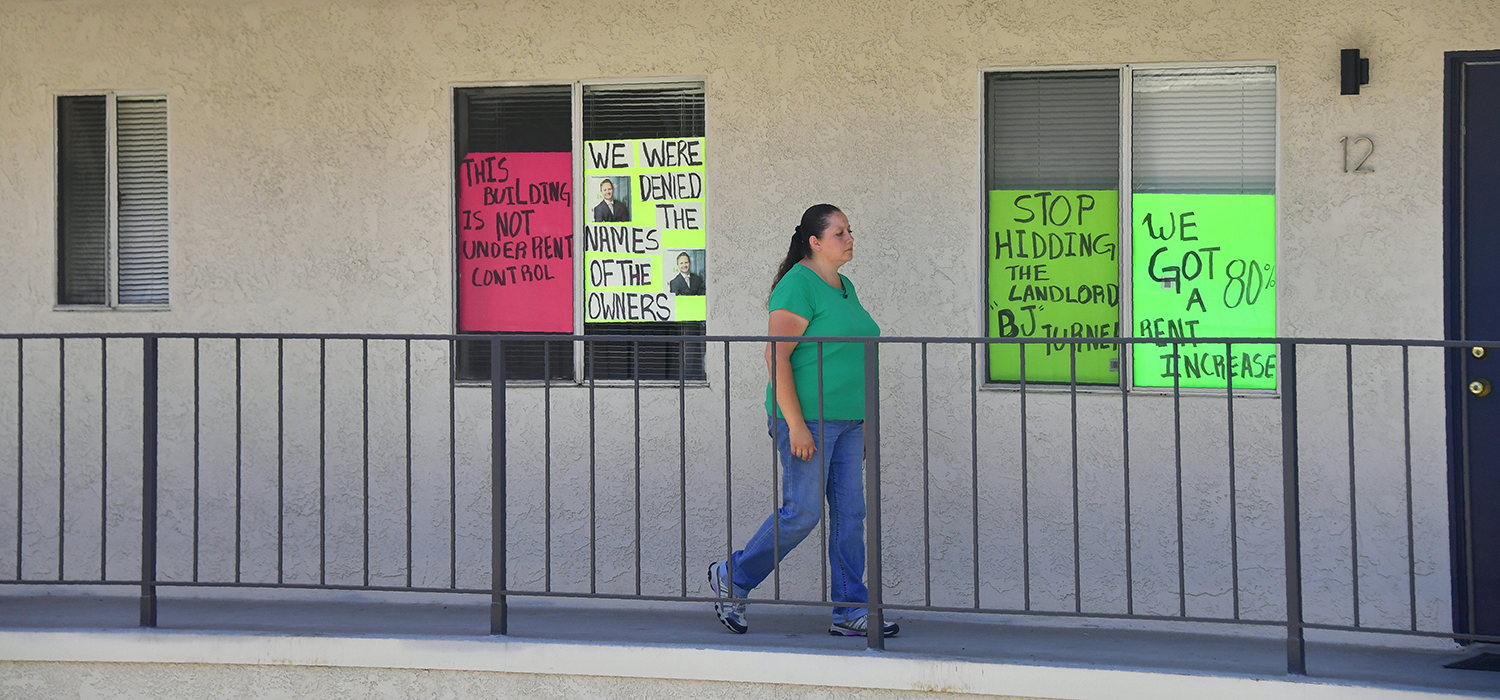
<p>Tenant Irma Aguilar walks past posters in front of homes, including hers, on a balcony in this apartment block where the landlord has increased some rentals by as much as $800 on August 3, 2017 in the Boyle Heights neighborhood of Los Angeles, California. (FREDERIC J. BROWN/AFP/Getty Images).</p>
In the midst of the affordable housing crisis, states are searching for policies that slow the rapid increase of rents in their most expensive cities. This year alone, California, New York, and Oregon passed statewide rent control laws, a stark break from the nationwide trend of states preempting local rent regulation.
Rent control has also made news in the presidential race. Democratic candidate Bernie Sanders’s Housing for All plan proposes a national rent control standard, as well as limits to preemption of local efforts.
Rent control’s revival has reinvigorated a polarized debate on its efficacy. Research shows that rent control benefits current tenants by decreasing their rent burden and protecting them from eviction and displacement. But there are concerns regarding its ability to target low-income tenants. Rent control may also have unintended negative consequences on the broader housing market, specifically in its impact on housing supply, quality, and overall rents.
The supply question is especially salient given the sharp decline in low-cost rental units over the past three decades. Our review of the research finds that rent control’s impact on housing supply depends on laws’ specific elements. Effects can vary widely depending on how laws deal with provisions such as condominium conversions, vacancy control, code enforcement, and regulatory loopholes. That’s why we need more research that engages with the diversity of existing policies and explores their effects.
Does rent control reduce housing supply?
The supply argument against rent control rests on two premises. First, it assumes rent control discourages developers from building new housing. And second, it assumes rent control creates disincentives to retain or maintain existing rental housing. But the evidence on these assumptions is mixed.
Rent control and new housing construction
The first supply-reduction claim alleging rent control’s negative effect on new housing development is supported by little evidence. Virtually all existing rent regulations, including the new statewide laws, exempt new construction. Indeed, empirical studies in New Jersey and Washington, DC, found no relationship between rent control and new housing development.
Some experts theorize that rent control negatively affects new housing construction because it could lower the rent of a neighborhood and, in turn, lower developers’ incentives to build there. But even when rent control suppresses rent and property values, it has a negligible effect on new construction. This is likely because housing construction responds more to broader macroeconomic factors.
Conversion and loss of rent-controlled housing
The argument that rent control pushes landlords to convert rental units into condominiums, cooperatives, and other types of nonrental property has more basis in evidence. A recent study on rent control expansion in San Francisco found that rent-controlled buildings were 8 percentage points more likely to convert to a condo or a tenancy in common than buildings in the control group, resulting in a 15 percentage point decline in the rental supply of small multifamily housing.
But rent control policies that also regulate condominium conversions can at least partially mitigate this effect. In San Francisco, the high conversion rate may be because of loopholes that allow landlords to convert buildings.
In fact, rent control under the proper regulatory framework may prevent some condo conversions that would otherwise occur. A study in Cambridge, Massachusetts, showed that the simultaneous repeal of rent control and conversion regulations allowed a substantial number of decontrolled houses, apartments, and nonresidential units to be converted to condominiums. The price and quality of units in previously controlled neighborhoods also increased in response to the repeal.
Finally, some evidence indicates rent control affects housing quality, as landlords may limit upkeep and maintenance on rent controlled buildings, which could eventually lead to a loss of rental supply. But the most recent research on rent control has shown mixed or modest real-world effects on housing quality, and those effects can be limited by policies that account for upkeep and improvements.
The impact of statewide rent control laws on housing supply
All three statewide laws passed this year address concerns about negative effects on new housing construction by exempting new buildings from rent control. But their impacts on the conversion of rental housing may differ.
New York’s law effectively prevents conversion of rent-stabilized units into condominiums or cooperatives by requiring 51 percent of current tenants to agree to buy a unit in the new property. New York City lost nearly 50,000 rent-stabilized units (PDF) to condo or co-op conversion from 1994 to 2017, so the new regulation will likely protect many rent-stabilized units that would otherwise be converted.
In contrast, neither California nor Oregon attempt to limit conversions. The allowable rent increases in both states are large, so there may not be an increase in conversions. But policymakers and researchers should keep an eye on this possibility.
Where should rent control go from here?
Rent regulation involves a diverse set of features, including tenant protections, rent caps, vacancy and conversion regulation, and various targeting mechanisms. The way policymakers tweak these elements can significantly change outcomes. We need more empirical research that focuses on how existing policies affect local and state housing markets and aims to identify regulations that produce the best outcomes for tenants.
Let’s build a future where everyone, everywhere has the opportunity and power to thrive
Urban is more determined than ever to partner with changemakers to unlock opportunities that give people across the country a fair shot at reaching their fullest potential. Invest in Urban to power this type of work.